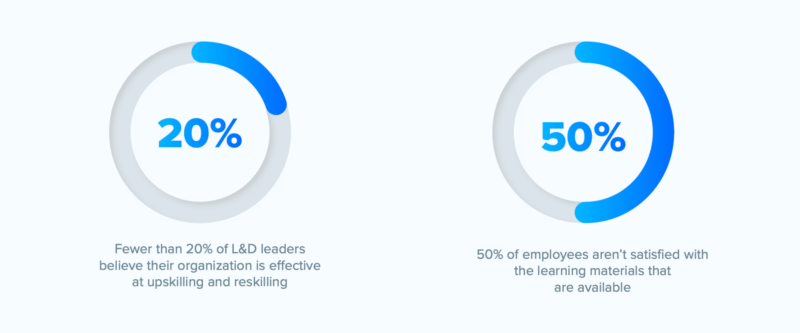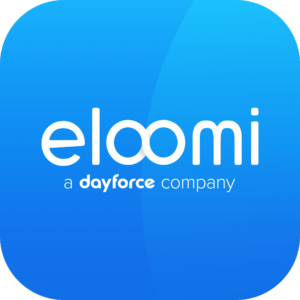Employee Skills Training: What To Know And Where To Start
The employee skills training marketplace is quickly becoming the most important focus area for growing organizations. People all over the world are starting to look for more meaningful connections with their work, job fulfillment, and real opportunities for career advancement. This change has shaken up entire job sectors, with a sudden need to rehire, replace, and retrain employees to fill new roles.
Meanwhile, the need to train new skills and adapt training on the go has skyrocketed. A recent study by Gartner found that nearly one in three skills needed for a job in 2018 will not be needed by 2023. But this growing trend has only intensified with the advent of remote work, digitalized workplaces, and shifting consumer demand.
All this means it's more important than ever before to have a skills strategy in place for your organization. Understanding what skills you have on hand in your talent pool and what skills' profiles you may be missing is vital to the success and growth of your organization.
Creating A Common Language Around Skills And Business Titles
Getting a skills overview can feel like a huge challenge. HR leaders and employees alike can struggle with using the right words to describe skills or even business titles. In the last few years, job titles have changed at an extraordinary rate. Your Head of Communications may now juggle a whole list of additional roles and responsibilities, including a Social Media Coordinator, a Digital Marketing Guru, and an Agile Team Coach.
A creative approach to business titles and agile movement between responsibilities is a hallmark of modern organizations with a strong focus on culture, so it's important that your business overview is just as flexible.
How To Build An Organizational Skills Map
So, let's break it down. A huge problem facing business leaders today is how to gain insight into what skills they have in their organization. Understanding this is key, not only because the demand for skills is growing but also because it's an essential step to ensuring the stability of your business for the future.
The first step you need to take to uncover the skillsets in your company is to create a skills map. This organizational overview gives you a crystal-clear view of the skills within your company. This can include insights on a departmental level, as well as individual roles and responsibilities.
Once you have this overview, you can start to see where you might be lacking skills profiles, which areas need training and investment, and where you might be vulnerable to future disruption.
So, how do you start to create a skills overview?
- Visualize your organization – Advances in HR tech now make it easier than ever to get an overview of your organizational structure, the different roles people fill, and the skills associated with their areas.
- Build a skills taxonomy – Create a formal map of roles, departments, and capabilities associated with your organization. This can be a real eye-opener to the complexity of even mid-size businesses.
- Break it down – While any HR professional will know their organizational charts from top to bottom, it's another question entirely when we start to break those titles down into the actual roles people are performing, the tasks they take on, and the skillset that makes them a uniquely valuable employee.
- Look for gaps – What roles are you missing, and which do you have in excess? Define high-risk or essential areas to invest your recruitment efforts into.
- Look ahead – Are there skills you're missing for future projects, expansions, or for management succession? Consider how you can gain those skills by developing current talent.
Understanding the network of job skills, titles, and their interconnections just 20 years ago was an enormous challenge. Now, with the rise of hybrid work, new organizational models, and the pandemic shakeup, change is accelerating at an unprecedented rate. This makes setting up business titles and related skills in eloomi a simple, intuitive process that grants insight into talent pools throughout your organization. It's not easy to stay ahead of global shifts in the way we work, but with Skills, you unlock organizational insights, the tools to enact change, and the power to deliver long-term development planning, all in one simple solution.

Why Employees Don't Always Engage With Skills Training
Employees want skills training at work. The data speaks for itself. LinkedIn Learning found that 76% of Gen Z learners believe learning is key to a successful career, and it isn't just a phenomenon linked to new generations, with two-thirds of people aged over 45 prepared to spend a significant amount of time learning new skills.
So, if the motivation is there, why do L&D professionals often struggle to get employees engaged with upskilling and reskilling initiatives? The answer is deceptively simple:
- Training needs the right motivations. Everyone wants to improve at their job, but it can be hard to connect the dots between your role and the skills you're invested in honing. This is where a solid strategy can power motivation, not only matching job roles with concrete skills that provide real value, but also empowering employees to consider personal talents and interests that drive them to engage with training.
- Learning needs to be relevant. Just as employees need to see the value of training, the learning they receive needs to be the right fit for their role, experience, and expectations.
- Focus requires time. Even when upskilling is available, it can be difficult for employees to feel they can prioritize taking the time to learn during the workday. This is where having a strong culture of learning in the office really shows. People need to feel empowered to upskill at work and to take time to become stronger, more valuable employees in a very real sense.
Knowing this, it's crucial to nail your skills strategy. Offering valuable training to your employees isn't just about expectations; it's a trusted approach to setting organizational goals and developing the right skillsets to stay agile in a changing market.

How Skills Training Keeps Your Organization Competitive
According to PwC, 74% of CEOs said that a lack of availability of the right skills is a concern, and the demand for new skills is only increasing. And this is just as true for HR and L&D leaders as it is for employees. This means that to stay competitive, businesses need an effective company-wide skills strategy.
Why Should You Invest In Skills Training?
Investing in building up your organizational knowledge is hugely beneficial for any business. Starting with a solid foundation of training and knowledge sharing allows businesses to hone talent within their organization. It creates a consistent flow for new hires as they go through onboarding, as well as forming a refresher for existing employees who may have more to bring to their role with a renewal of interest.
In addition to engaging employees and building new capabilities, having a skills strategy in place can help you identify leadership and management potential in your employees, looking beyond performance by examining the skills potential and passion of employees who might otherwise be overlooked.
Promoting skills building in your organization also drives employee retention. According to The State of L&D Report, 76% of employees agree that they are more likely to stay with a company that offers continuous training. This trend has only continued with hybrid workspaces and the need for businesses to find new ways to connect with their teams.
Taking time to plan skill-building initiatives can feel like a big investment, but it's one which pays off three-fold with a united company culture, employee engagement and retention, and stronger teams working across departments to deliver results.
Understanding the network of job skills and titles was an enormous challenge just 20 years ago. Now, with hybrid work and new organizational models, change is accelerating at an unprecedented rate.
Upskilling And Reskilling The Right Way
The best learning approach is one which inspires employees, draws teams together, and drives business goals. It's not just about understanding what skills you have in your organization but also unlocking the tools to provide long-term people development to build a stronger organization.
So, as you start to plan your upskilling strategy, keep these key takeaways in mind:
- Think big picture. Advances in HR tech now make it easier than ever to get an overview of your organizational structure, the different roles people fill, and the skills associated with their areas.
- Go digital. Learning is a challenge when it isn't available on demand. And this factor has only grown more pressing with the rise of the hybrid workplace. With employees working from home or needing remote access to company platforms, it's essential that skills training is accessible whenever and wherever you need it.
- Support employees. Ensure that managers and teams are in the loop on your upskilling process. It's important that employees feel enabled to access learning at work, and one of the best ways to promote this atmosphere is to have managers who are there to listen to employees and give them the boost they need to grow and improve in their roles.
- Learn in teams. Just as managers should be involved, colleagues and teams can work together to create a true atmosphere of learning in the office. Whether employees are assigned training in groups, hold feedback and support sessions, or compete to complete courses, teamwork can be an invaluable tool to incentivize training and create a true culture of learning.
- Use online resources. Take away the hassle of searching for the right content by connecting with an LMS that incorporates content providers and offers off-the-shelf courses from industry experts.
- Try blended learning. Learning in the flow of work is here to stay, with employees breaking up their workday with microlearning and lesson enrichment to inspire and help them accomplish new tasks on the go.
Learning and Development doesn't have to be a logistical challenge. Transitioning to a skill-based organization will give you insight into the real capabilities of your organization, connecting you with the right tools to upskill employees and delivering true people development for the future of work.
Supporting Employee Skills Training With The Right Content
HR industry expert Josh Bersin has argued that businesses cannot hire their way into growth. This means that with growing skill gaps, it's all the more important to invest in existing training, but this is impossible without the right medium and the right content to support growth.
Alongside the growing need for upskilling and reskilling throughout industries, businesses have also been facing increasing difficulty in accessing and finding the right content to deliver meaningful employee training. L&D experts are faced with long provider qualification rounds, tricky research, and slow turnaround times to provide the content they need to deliver employee training goals.
In essence, skills training serves as the catalyst for employees to unlock their inherent talents, cultivate new competencies, or enhance existing ones. This comprehensive approach encompasses various learning methods that address both hard and soft skills.
Conclusion
Skills training isn't just a means to fill gaps; it's the cornerstone of organizational stability and growth. Investing in skills training is a strategic move that pays off with a unified company culture. It's an investment in organizational knowledge, people development, and retention of top talent.

Originally published at eloomi.com.

